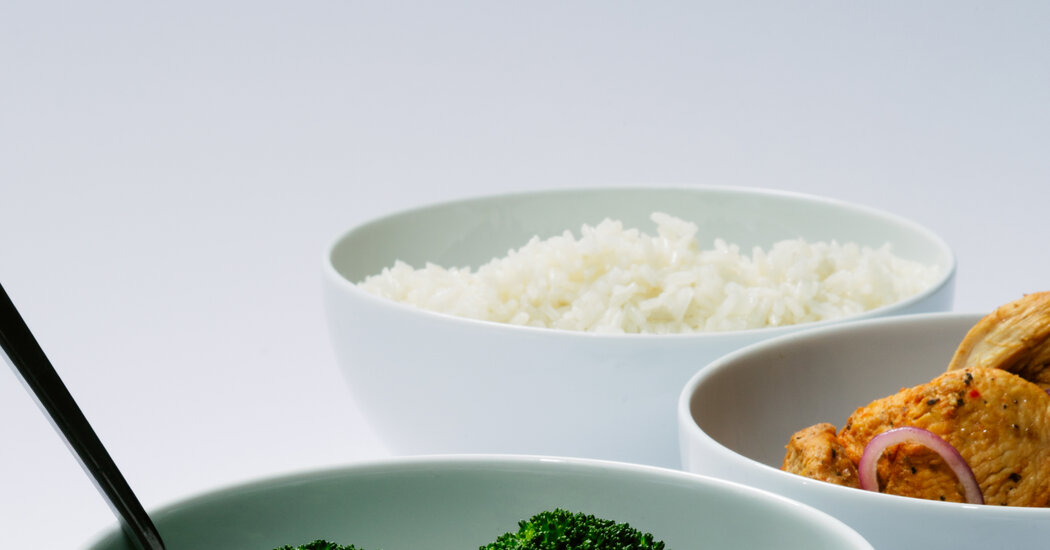Q: I’ve heard that it’s best for my health to eat a salad before dinner. But if I’m eating vegetables regardless, does the order really matter?
It’s a popular internet health hack: Eat foods in the “right” order — vegetables first, proteins and fats second, carbohydrates last — and you’ll significantly reduce your resulting spike in blood sugar, which can therefore reduce cravings, fatigue and health risks like Type 2 diabetes, proponents say.
Past research on the topic, sometimes referred to as nutrient or meal sequencing, has concluded that it can indeed benefit blood sugar, especially for those with Type 2 diabetes or pre-diabetes.
For everyone else, it’s not as cut-and-dried, said Dr. Alpana Shukla, a physician and researcher at Weill Cornell Medicine in New York City who has studied food order. Though there are some reasons to consider giving it a try, she said.
What does the research suggest?
Existing studies on the benefits of meal sequencing are small, but the results are consistent, experts say.
In one 2023 review of 11 studies, for instance, researchers concluded that people who saved carbohydrate-rich foods for the end of a meal, after vegetables and proteins, had significantly lower blood sugar levels than when they consumed them first.
In one 2019 study of 15 people with pre-diabetes, Dr. Shukla and her colleagues asked the participants to eat a meal of skinless grilled chicken, salad and ciabatta in three different orders on three different days: ciabatta first, followed 10 minutes later by the chicken and salad; chicken and salad first, followed by the ciabatta; and salad first, followed by the chicken and ciabatta.
Researchers measured participants’ blood sugar levels right before they ate, and every 30 minutes for three hours after each meal. They found that when the participants ate the chicken and salad before the bread, their blood sugar spikes following the meal were about 46 percent lower than when they ate the bread first.
Researchers aren’t entirely sure why this might be. One theory is that eating fats, fiber and proteins first delays stomach emptying, which could slow the absorption of sugars from the carbohydrates into the bloodstream, Dr. Shukla said.
Barbara Eichorst, vice president of health care programs at the American Diabetes Association, said it makes sense for people with Type 2 diabetes or pre-diabetes to consume vegetables and proteins first during meals, since, unlike carbohydrates, vegetables and proteins don’t rapidly turn into sugar and cause high blood glucose spikes.
For those who have Type 2 diabetes, some limited research even suggests that this blood sugar lowering effect could be comparable with certain diabetes medications, said Nicola Guess, a clinical dietitian and researcher at the University of Oxford in Britain. Though more research is needed on the topic.
Should everyone eat like this?
Research has also shown that eating carbohydrates last in a meal can reduce blood sugar spikes in people who don’t have diabetes. But the experts said that healthy people usually don’t need to micromanage their blood sugar in this way.
A properly functioning body will bring blood sugar levels back down to normal within hours after eating a meal, said Dr. Vijaya Surampudi, an endocrinologist at UCLA Health.
Nonetheless, since proteins, fats and fiber-rich vegetables take longer to digest than simple carbohydrates, saving carbs for last can help people feel fuller for longer, said Dr. Domenico Tricò, an assistant professor of internal medicine at the University of Pisa in Italy who studies food order.
Research also suggests that eating this way can stimulate the gut to produce more of a satiety hormone called glucagon-like peptide 1, or GLP-1. (The diabetes drug Ozempic is designed to mimic this hormone.)
“GLP-1 slows digestion and tells your brain you’re not hungry,” Dr. Surampudi said. But some experts said it’s not clear if the small increases in this hormone from meal sequencing alone (compared with the large increase you’d get from a drug like Ozempic) would make a big difference in how sated you feel.
If you tend to feel sluggish after meals, front-loading them with vegetables or protein could help, Dr. Shukla and Dr. Surampudi said.
Some research also suggests that saving carbohydrates for the end of a meal can make you more likely to fill up on vegetables and protein and eat fewer simple carbohydrates, which tend to have fewer nutrients and more calories, Dr. Shukla said.
The bottom line, the experts said, is that while meal sequencing is one of many healthy eating strategies, it’s not something to stress about. Dietary trends like these sometimes result in making people anxious, which can lead to disordered eating.
“If it’s easy for you, then you should go for it,” Dr. Tricò said. But if not, just aim for high-quality food you enjoy. Loading up on vegetables at every meal is more important than focusing too intently on the order of your food, Dr. Guess said.
Nikki Campo is a freelance writer in North Carolina.







